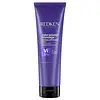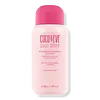What's inside
What's inside
 Key Ingredients
Key Ingredients

No key ingredients
 Benefits
Benefits

 Concerns
Concerns

 Ingredients Side-by-side
Ingredients Side-by-side

Water
Skin ConditioningCetearyl Alcohol
EmollientBehentrimonium Chloride
PreservativeParaffinum Liquidum
EmollientGlycerin
HumectantParfum
MaskingPhenoxyethanol
PreservativePEG-40/PPG-8 Methylaminopropyl/Hydroxypropyl Dimethicone Copolymer
Isopropyl Alcohol
SolventDipropylene Glycol
HumectantCI 60730
Cosmetic ColorantCI 17200
Cosmetic ColorantCitric Acid
BufferingChlorhexidine Digluconate
AntimicrobialLinalool
PerfumingArginine
MaskingGlutamic Acid
HumectantSerine
MaskingHydroxypropyltrimonium Hydrolyzed Wheat Protein
Skin ConditioningCoumarin
PerfumingWater, Cetearyl Alcohol, Behentrimonium Chloride, Paraffinum Liquidum, Glycerin, Parfum, Phenoxyethanol, PEG-40/PPG-8 Methylaminopropyl/Hydroxypropyl Dimethicone Copolymer, Isopropyl Alcohol, Dipropylene Glycol, CI 60730, CI 17200, Citric Acid, Chlorhexidine Digluconate, Linalool, Arginine, Glutamic Acid, Serine, Hydroxypropyltrimonium Hydrolyzed Wheat Protein, Coumarin
Water
Skin ConditioningSodium Lauroyl Methyl Isethionate
CleansingSodium C14-16 Olefin Sulfonate
CleansingGlycerin
HumectantCocamidopropyl Betaine
CleansingSodium Lauroyl Sarcosinate
CleansingDecyl Glucoside
CleansingAcrylates Crosspolymer-4
Emulsion StabilisingBehenyl/Stearyl Aminopropanediol Esters
Sodium Cocoyl Amino Acids
CleansingPanthenol
Skin ConditioningMusa Sapientum Fruit Extract
Skin ConditioningPsidium Guajava Fruit Extract
AstringentCocos Nucifera Oil
MaskingHelianthus Annuus Seed Oil
EmollientPotassium Dimethicone PEG-7 Panthenyl Phosphate
Skin ConditioningGlycol Distearate
EmollientSodium Lauroyl Lactylate
EmulsifyingSodium Chloride
MaskingCoco-Glucoside
CleansingPhenethyl Benzoate
EmollientGlyceryl Oleate
EmollientPropylene Glycol
HumectantCaprylic/Capric Triglyceride
MaskingPolyglyceryl-4 Caprate
EmulsifyingTrisodium Ethylenediamine Disuccinate
Sodium Laurate
CleansingSodium Sarcosinate
Glyceryl Stearate
EmollientCitric Acid
BufferingPotassium Sorbate
PreservativeTetrasodium EDTA
Tocopherol
AntioxidantCeteareth-60 Myristyl Glycol
EmulsifyingDicocoylethyl Hydroxyethylmonium Methosulfate
Guar Hydroxypropyltrimonium Chloride
Skin ConditioningPolyquaternium-10
Polyquaternium-7
Sodium Benzoate
MaskingPEG-120 Methyl Glucose Dioleate
EmulsifyingBenzyl Alcohol
PerfumingBenzoic Acid
MaskingCI 17200
Cosmetic ColorantCoumarin
PerfumingHexyl Cinnamal
PerfumingParfum
MaskingWater, Sodium Lauroyl Methyl Isethionate, Sodium C14-16 Olefin Sulfonate, Glycerin, Cocamidopropyl Betaine, Sodium Lauroyl Sarcosinate, Decyl Glucoside, Acrylates Crosspolymer-4, Behenyl/Stearyl Aminopropanediol Esters, Sodium Cocoyl Amino Acids, Panthenol, Musa Sapientum Fruit Extract, Psidium Guajava Fruit Extract, Cocos Nucifera Oil, Helianthus Annuus Seed Oil, Potassium Dimethicone PEG-7 Panthenyl Phosphate, Glycol Distearate, Sodium Lauroyl Lactylate, Sodium Chloride, Coco-Glucoside, Phenethyl Benzoate, Glyceryl Oleate, Propylene Glycol, Caprylic/Capric Triglyceride, Polyglyceryl-4 Caprate, Trisodium Ethylenediamine Disuccinate, Sodium Laurate, Sodium Sarcosinate, Glyceryl Stearate, Citric Acid, Potassium Sorbate, Tetrasodium EDTA, Tocopherol, Ceteareth-60 Myristyl Glycol, Dicocoylethyl Hydroxyethylmonium Methosulfate, Guar Hydroxypropyltrimonium Chloride, Polyquaternium-10, Polyquaternium-7, Sodium Benzoate, PEG-120 Methyl Glucose Dioleate, Benzyl Alcohol, Benzoic Acid, CI 17200, Coumarin, Hexyl Cinnamal, Parfum
Ingredients Explained
These ingredients are found in both products.
Ingredients higher up in an ingredient list are typically present in a larger amount.
Ci 17200 is a synthetic reddish-purple dye.
Citric Acid is an alpha hydroxy acid (AHA) naturally found in citrus fruits like oranges, lemons, and limes.
Like other AHAs, citric acid can exfoliate skin by breaking down the bonds that hold dead skin cells together. This helps reveal smoother and brighter skin underneath.
However, this exfoliating effect only happens at high concentrations (20%) which can be hard to find in cosmetic products.
Due to this, citric acid is usually included in small amounts as a pH adjuster. This helps keep products slightly more acidic and compatible with skin's natural pH.
In skincare formulas, citric acid can:
While it can provide some skin benefits, research shows lactic acid and glycolic acid are generally more effective and less irritating exfoliants.
Most citric acid used in skincare today is made by fermenting sugars (usually from molasses). This synthetic version is identical to the natural citrus form but easier to stabilize and use in formulations.
Read more about some other popular AHA's here:
Learn more about Citric AcidCoumarins are a group of substances found naturally in plants. There are over 1300 types of coumarins identified. It has a natural vanilla scent.
Coumarin is an identified EU known allergy, meaning it may cause an allergic reaction when applied to the skin.
In many countries, coumarin is banned as a food additive. However, it can be found in soaps, tobacco products, and some alcohol drinks.
Plants use coumarins as a chemical defense. Some plants that have coumarins include lavender, tonka beans, and yellow clovers.
Learn more about CoumarinGlycerin is already naturally found in your skin. It helps moisturize and protect your skin.
A study from 2016 found glycerin to be more effective as a humectant than AHAs and hyaluronic acid.
As a humectant, it helps the skin stay hydrated by pulling moisture to your skin. The low molecular weight of glycerin allows it to pull moisture into the deeper layers of your skin.
Hydrated skin improves your skin barrier; Your skin barrier helps protect against irritants and bacteria.
Glycerin has also been found to have antimicrobial and antiviral properties. Due to these properties, glycerin is often used in wound and burn treatments.
In cosmetics, glycerin is usually derived from plants such as soybean or palm. However, it can also be sourced from animals, such as tallow or animal fat.
This ingredient is organic, colorless, odorless, and non-toxic.
Glycerin is the name for this ingredient in American English. British English uses Glycerol/Glycerine.
Learn more about GlycerinParfum is a catch-all term for an ingredient or more that is used to give a scent to products.
Also called "fragrance", this ingredient can be a blend of hundreds of chemicals or plant oils. This means every product with "fragrance" or "parfum" in the ingredients list is a different mixture.
For instance, Habanolide is a proprietary trade name for a specific aroma chemical. When used as a fragrance ingredient in cosmetics, most aroma chemicals fall under the broad labeling category of “FRAGRANCE” or “PARFUM” according to EU and US regulations.
The term 'parfum' or 'fragrance' is not regulated in many countries. In many cases, it is up to the brand to define this term.
For instance, many brands choose to label themselves as "fragrance-free" because they are not using synthetic fragrances. However, their products may still contain ingredients such as essential oils that are considered a fragrance by INCI standards.
One example is Calendula flower extract. Calendula is an essential oil that still imparts a scent or 'fragrance'.
Depending on the blend, the ingredients in the mixture can cause allergies and sensitivities on the skin. Some ingredients that are known EU allergens include linalool and citronellol.
Parfum can also be used to mask or cover an unpleasant scent.
The bottom line is: not all fragrances/parfum/ingredients are created equally. If you are worried about fragrances, we recommend taking a closer look at an ingredient. And of course, we always recommend speaking with a professional.
Learn more about ParfumWater. It's the most common cosmetic ingredient of all. You'll usually see it at the top of ingredient lists, meaning that it makes up the largest part of the product.
So why is it so popular? Water most often acts as a solvent - this means that it helps dissolve other ingredients into the formulation.
You'll also recognize water as that liquid we all need to stay alive. If you see this, drink a glass of water. Stay hydrated!
Learn more about Water